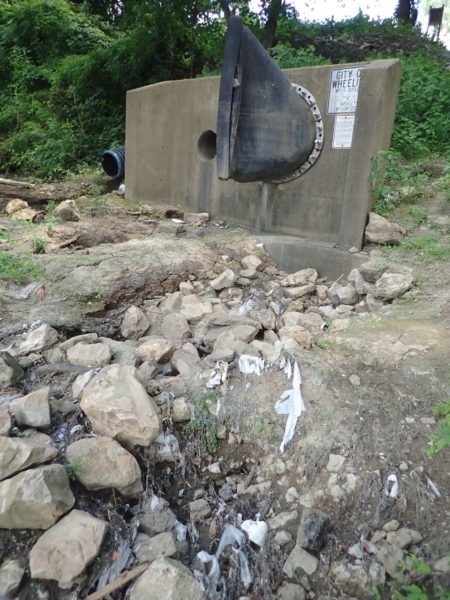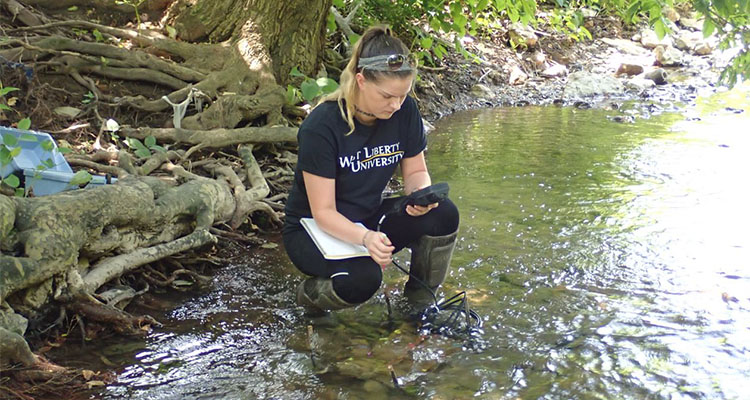While there’s no denying the beauty of our local waterways and the rising popularity of recreational kayaking, there’s also no denying that our creeks and rivers show the effects of pollution. Sewage, acid mine drainage and sedimentation all affect the health of a stream and, in turn, the vibrancy of the community through which it flows. We love our waterways; among others, Wheeling Creek, Fish Creek and Buffalo Creek all represent wild and beautiful places in our counties.
I’d just paddled Wheeling Creek for the first time. Now it was time to talk to a biologist about what I couldn’t see.
Experts Look for Invertebrates
James Wood is a new faculty member at West Liberty University, and he and his students are studying our waterways.
“What my students are doing specifically is looking at the water chemistry in Wheeling Creek,” Wood said. “We’ve got a couple different things going on. My goal is to create a water quality monitoring program where students and other interested citizens are regularly going out and collecting aquatic invertebrates from the stream because they can tell us so much about how healthy the water is. Because these bugs live in there, day after day, if the water is routinely bad, the sensitive ones die out. And only the really tolerant, pollution-tolerant species survives. And so it’s a lot more effective at trying to understand water quality than just going out and sticking a meter in the stream.”
Students measure things such as pH and conductivity. The latter is a measure of how much salt is in the water. In this area, we have very high conductivity. One reason for this is the geology of the area, but sewer lines, road salt runoff and heavy industry also contribute to the problem. Ultimately, the insects that evolved to live in freshwater streams find themselves trying to survive in brackish water. And that’s a bad deal for the bugs.
A healthy stream should be home to flies like stoneflies, caddisflies and mayflies. Wood’s students look for them. The presence or absence of some or all of these species can be a yardstick for water quality. Wood said when even the ubiquitous dragonfly is absent, a stream is in real trouble.
“That’s when you know your water quality is really bad,” he said and told me the stream that runs through Woodsdale — the one known for flooding in recent years — is almost entirely devoid of life due to its high conductivity.
When I asked about hellbenders, Wood said they do live upstream of Wheeling, but in lower Wheeling Creek, they’re hard to find. Sedimentation is the giant salamanders’ biggest problem; they live under rocks, and when those spaces fill with dirt, they have nowhere to go. Buffalo Creek still has plenty of hellbenders.
This fall, Wood’s students will begin measuring E. coli levels. This is where the city’s sewers come into play.
“We have an old city,” Wood explained, “and the old way of making sewer lines and storm drains was that the sewer lines ran along the streams, and then the storm drains would drop into them. And then what happens is when we get big rain events, too much water runs into them, and they’re basically outlets called combined sewer overflow, CSOs. And then those will dump raw sewage into the stream. The city is working on getting rid of those, but it’s a process. And that’s where kayaking comes in because, you know, being new to Wheeling, I think it’s a beautiful city, and I want to see it continue to get its legs back underneath it. I also want to see it grow and be able to embrace some of these kinds of natural benefits, you know, natural recreational opportunities.”
The City of Wheeling once had over 250 CSOs, one of the highest numbers in the northeast. Currently, about 40 still exist. A 20-year plan to separate the combined system has been on hold since 2014 due to budgetary constraints.

Students at Work
Wood’s students are enthusiastic about the project.
“I’m sending students out to the streams and they’re coming back with interesting, sometimes disgusting stories,” he said. “I think it’s important [for them] that these connections get made. I don’t think any of them had a knowledge of how it worked. Like most of us, you know, you flush the toilet and it goes away, runs off the road, and it goes to that magical place called ‘away.’ I think that they’re kind of appalled when they realize that’s what’s happening. But I try to make sure that they also understand that what they’re doing is helping to lay the foundation for moving forward. The city’s already taken action. And what we’re trying to do is collect the data on where are we now.”
Students are often surprised by the differences between a stream in Wheeling compared to one in Bethany, like Buffalo Creek. Wood says they’re disheartened when they see trash or sewage in the water. Ultimately, though, their experiences compel them to proceed with the study, and he says they’re dedicated to making a difference.
The goal here is to give Wood a look at the bigger picture. Are things getting better? Are they getting worse? Staying the same? His students are helping him identify problem areas. Once that’s done, the city will have a clear idea of where to focus its efforts. After all, clean water isn’t just good for the flies; it offers economic benefits, too.
“It’s the synergism of people going outside, recreating outside, people being healthier,” Wood said. “And that gives the feeling of vibrancy to the city. And I want to help encourage that, as well as create valuable learning opportunities for my students. And I want them to know that what they’re doing is not just some intellectual pursuit that doesn’t really mean anything, but that we’re trying to collect data to help us understand what’s happening, and that we can work with the city to help improve water quality, to identify places where water quality is bad and where it’s good so that the city can assess where it needs to spend money.”
What We Can Do
By now, you may be feeling a little down about things. Doesn’t all environmental writing do that, to some extent? There are so many ecological issues we simply cannot control. The good news is that we can help our local waterways, and by doing so, we’re improving our own quality of life.
Obviously, removing trash from the creeks helps. If you’re on the water, take your garbage with you. In April, the city and Williams Lea Tag organized a “Make Wheeling Shine” community event. Volunteers walked the creek’s shoreline and paddled down, collecting rubbish as they went. It’s a start.
Sewage pollution isn’t hopeless, either. Part of the issue, said Jesse Mestrovic, director of parks and strategic planning for the city of Wheeling, is that residents’ downspouts often flow into the sanitary sewer. During a heavy rain, this exacerbates the overflow problem, and Wheeling Creek suffers the consequences. Additionally, runoff from pavement directs water into the sewers.
“What we really need is to educate the citizens about removing their downspouts from the sanitary sewer and discharging them into their yard. This, in turn, would eventually trickle to the storm sewer and allow some natural absorption,” Mestrovic explained. Doing so will take the burden off the CSOs and keep pollution out of the creek. It’s easy and inexpensive to direct your downspouts toward your plants or into a rain barrel. You can even put in a beautiful rain garden for the express purpose of drainage (talk to the great folks at the Schrader Center about it).
Mestrovic also envisions a caretaking movement for the creek. The Three Rivers Waterkeeper organization in Pittsburgh protects the water quality of the Monongahela, Allegheny and Ohio rivers and their respective watersheds. They patrol the rivers, monitor water quality and support community education. Friends of the Cheat is a non-profit watershed group working to restore the Cheat River in a similar manner.
It’s not a bad idea.
Let’s think about it, Ohio Valley. We could do it. If we want positive change, we need to put our heads together. We’re blessed with rolling hills and bountiful waterways. Time in nature is proven to make us healthier and happier. If you haven’t yet paddled our creeks, give it a try. We’ve got this one earth and this one life — don’t spend it hunched over your computer. Shut the laptop, put down the phone.
It’s better out there.
PART 1: Paddling With Care
• Laura Jackson Roberts is a freelance writer in Wheeling, W.Va. She holds an MFA in Creative Writing from Chatham University and writes about nature and the environment. Her work has recently appeared in Brain, Child Magazine, Vandaleer, Animal, Matador Network, Defenestration, The Higgs Weldon and the Erma Bombeck humor site. Laura is the Northern Panhandle representative for West Virginia Writers, a blog editor for Literary Mama Magazine and a member of Ohio Valley Writers. She recently finished her first book of humor. Laura lives in Wheeling with her husband and their sons. Visit her online at www.laurajacksonroberts.com.




